Competitive Strategy Analysis
VerifiedAdded on 2023/01/23
|8
|1725
|38
AI Summary
This document provides an analysis of different competitive strategy frameworks including PESTEL framework, SWOT framework, Porter's five forces framework, and Porter's Generic Strategies. It explains the concepts and provides examples of their application in various industries. The document also discusses the impact of external factors on organizations' strategies and the importance of competitive advantage.
Contribute Materials
Your contribution can guide someone’s learning journey. Share your
documents today.
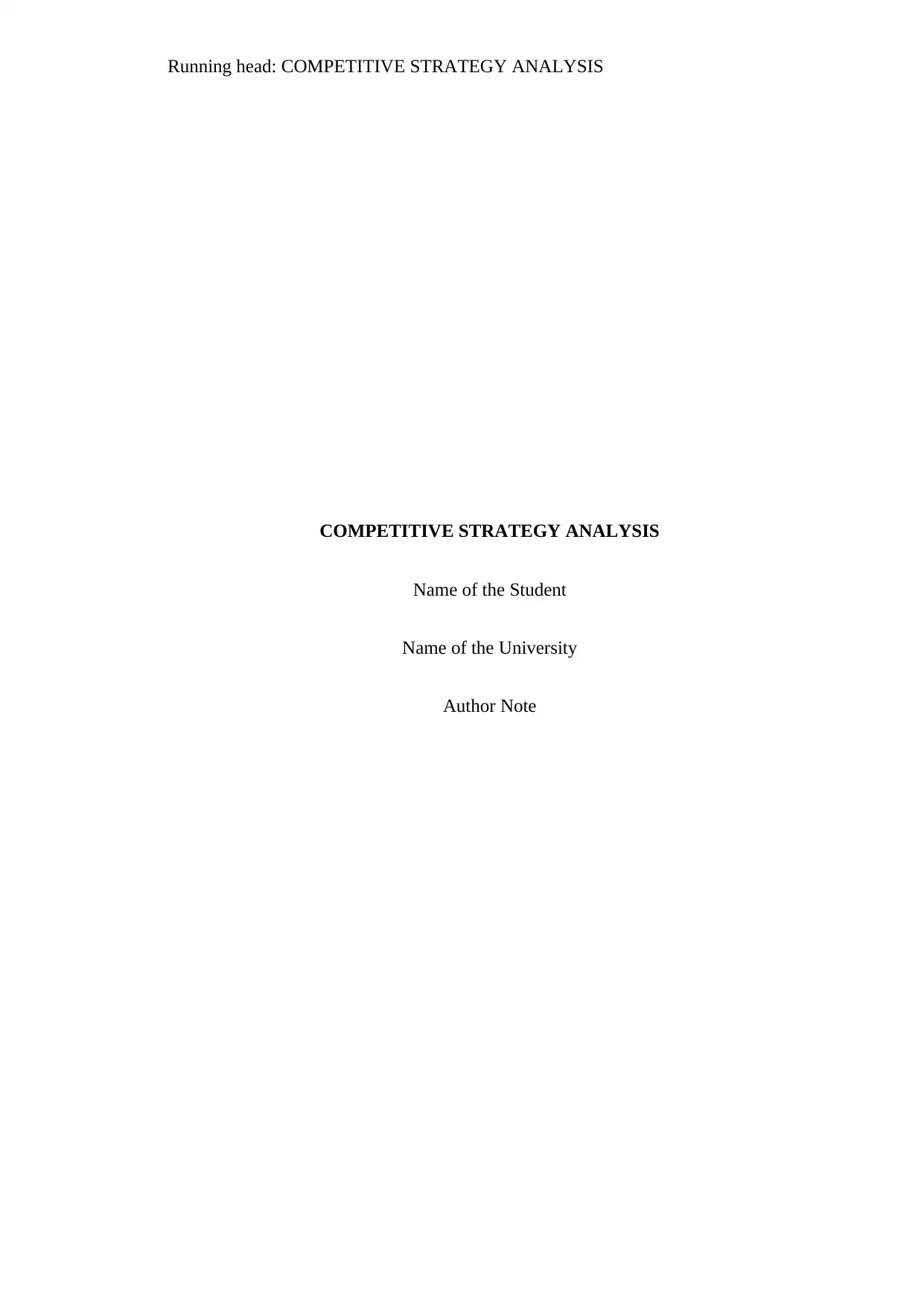
Running head: COMPETITIVE STRATEGY ANALYSIS
COMPETITIVE STRATEGY ANALYSIS
Name of the Student
Name of the University
Author Note
COMPETITIVE STRATEGY ANALYSIS
Name of the Student
Name of the University
Author Note
Secure Best Marks with AI Grader
Need help grading? Try our AI Grader for instant feedback on your assignments.
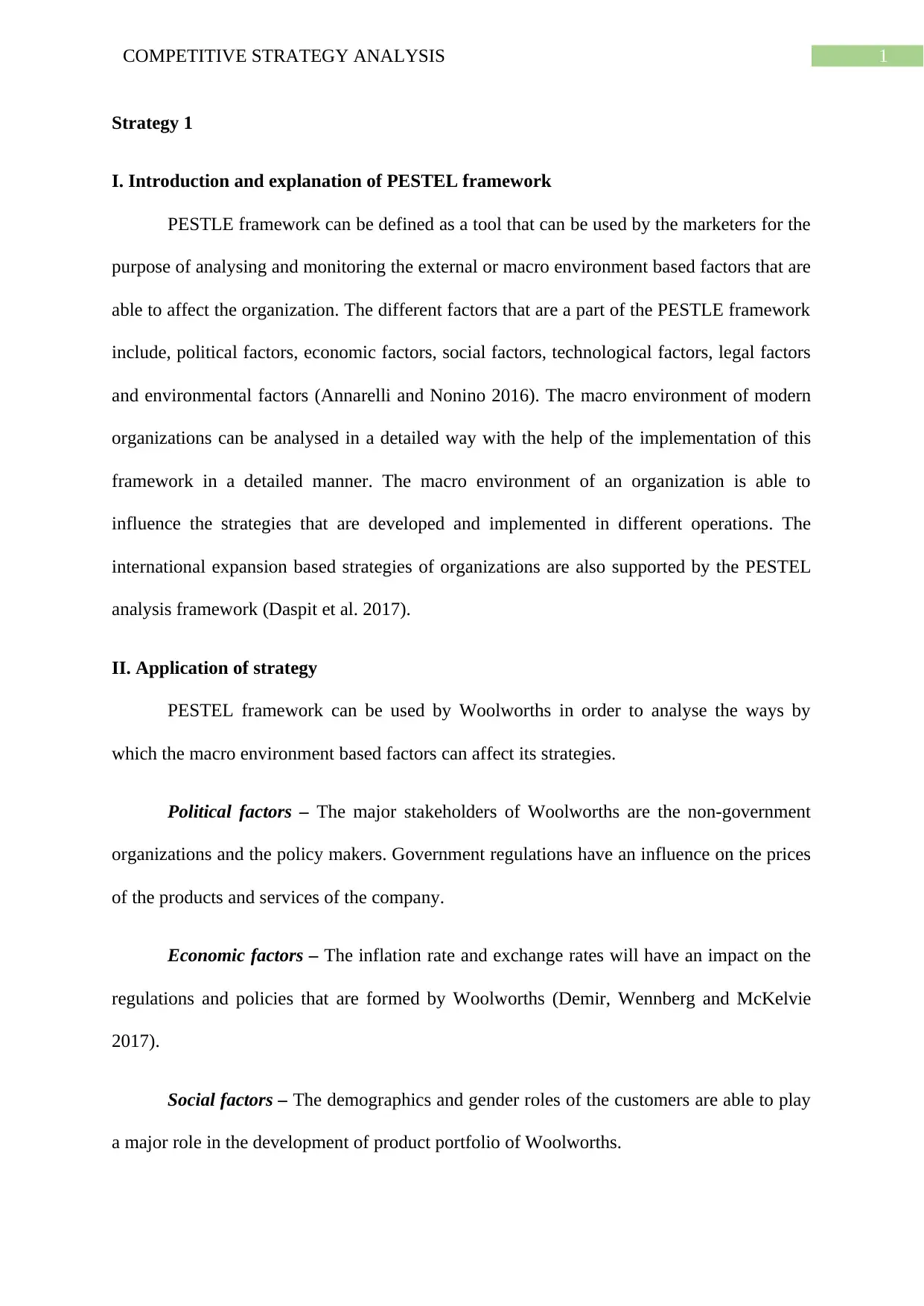
1COMPETITIVE STRATEGY ANALYSIS
Strategy 1
I. Introduction and explanation of PESTEL framework
PESTLE framework can be defined as a tool that can be used by the marketers for the
purpose of analysing and monitoring the external or macro environment based factors that are
able to affect the organization. The different factors that are a part of the PESTLE framework
include, political factors, economic factors, social factors, technological factors, legal factors
and environmental factors (Annarelli and Nonino 2016). The macro environment of modern
organizations can be analysed in a detailed way with the help of the implementation of this
framework in a detailed manner. The macro environment of an organization is able to
influence the strategies that are developed and implemented in different operations. The
international expansion based strategies of organizations are also supported by the PESTEL
analysis framework (Daspit et al. 2017).
II. Application of strategy
PESTEL framework can be used by Woolworths in order to analyse the ways by
which the macro environment based factors can affect its strategies.
Political factors – The major stakeholders of Woolworths are the non-government
organizations and the policy makers. Government regulations have an influence on the prices
of the products and services of the company.
Economic factors – The inflation rate and exchange rates will have an impact on the
regulations and policies that are formed by Woolworths (Demir, Wennberg and McKelvie
2017).
Social factors – The demographics and gender roles of the customers are able to play
a major role in the development of product portfolio of Woolworths.
Strategy 1
I. Introduction and explanation of PESTEL framework
PESTLE framework can be defined as a tool that can be used by the marketers for the
purpose of analysing and monitoring the external or macro environment based factors that are
able to affect the organization. The different factors that are a part of the PESTLE framework
include, political factors, economic factors, social factors, technological factors, legal factors
and environmental factors (Annarelli and Nonino 2016). The macro environment of modern
organizations can be analysed in a detailed way with the help of the implementation of this
framework in a detailed manner. The macro environment of an organization is able to
influence the strategies that are developed and implemented in different operations. The
international expansion based strategies of organizations are also supported by the PESTEL
analysis framework (Daspit et al. 2017).
II. Application of strategy
PESTEL framework can be used by Woolworths in order to analyse the ways by
which the macro environment based factors can affect its strategies.
Political factors – The major stakeholders of Woolworths are the non-government
organizations and the policy makers. Government regulations have an influence on the prices
of the products and services of the company.
Economic factors – The inflation rate and exchange rates will have an impact on the
regulations and policies that are formed by Woolworths (Demir, Wennberg and McKelvie
2017).
Social factors – The demographics and gender roles of the customers are able to play
a major role in the development of product portfolio of Woolworths.
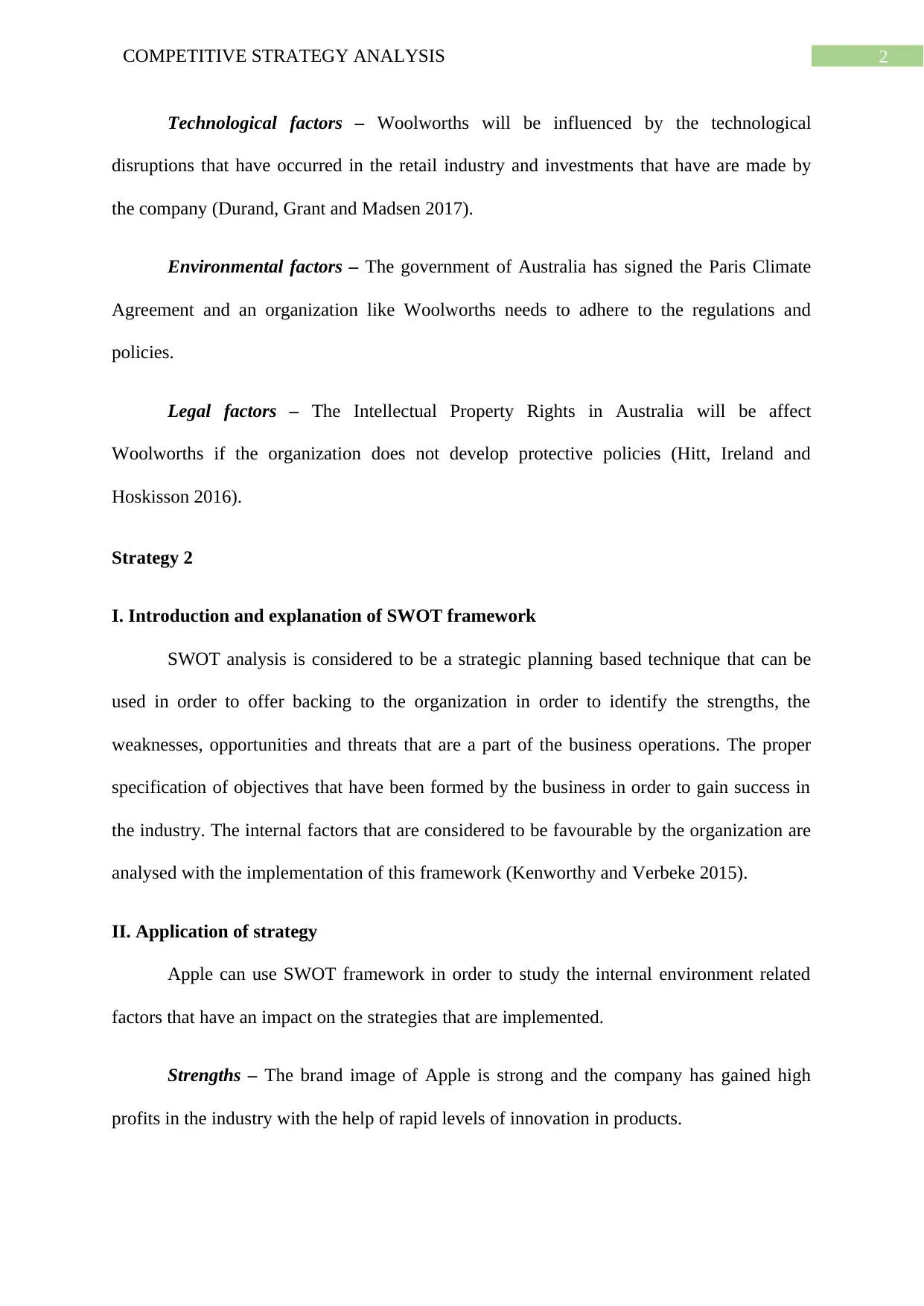
2COMPETITIVE STRATEGY ANALYSIS
Technological factors – Woolworths will be influenced by the technological
disruptions that have occurred in the retail industry and investments that have are made by
the company (Durand, Grant and Madsen 2017).
Environmental factors – The government of Australia has signed the Paris Climate
Agreement and an organization like Woolworths needs to adhere to the regulations and
policies.
Legal factors – The Intellectual Property Rights in Australia will be affect
Woolworths if the organization does not develop protective policies (Hitt, Ireland and
Hoskisson 2016).
Strategy 2
I. Introduction and explanation of SWOT framework
SWOT analysis is considered to be a strategic planning based technique that can be
used in order to offer backing to the organization in order to identify the strengths, the
weaknesses, opportunities and threats that are a part of the business operations. The proper
specification of objectives that have been formed by the business in order to gain success in
the industry. The internal factors that are considered to be favourable by the organization are
analysed with the implementation of this framework (Kenworthy and Verbeke 2015).
II. Application of strategy
Apple can use SWOT framework in order to study the internal environment related
factors that have an impact on the strategies that are implemented.
Strengths – The brand image of Apple is strong and the company has gained high
profits in the industry with the help of rapid levels of innovation in products.
Technological factors – Woolworths will be influenced by the technological
disruptions that have occurred in the retail industry and investments that have are made by
the company (Durand, Grant and Madsen 2017).
Environmental factors – The government of Australia has signed the Paris Climate
Agreement and an organization like Woolworths needs to adhere to the regulations and
policies.
Legal factors – The Intellectual Property Rights in Australia will be affect
Woolworths if the organization does not develop protective policies (Hitt, Ireland and
Hoskisson 2016).
Strategy 2
I. Introduction and explanation of SWOT framework
SWOT analysis is considered to be a strategic planning based technique that can be
used in order to offer backing to the organization in order to identify the strengths, the
weaknesses, opportunities and threats that are a part of the business operations. The proper
specification of objectives that have been formed by the business in order to gain success in
the industry. The internal factors that are considered to be favourable by the organization are
analysed with the implementation of this framework (Kenworthy and Verbeke 2015).
II. Application of strategy
Apple can use SWOT framework in order to study the internal environment related
factors that have an impact on the strategies that are implemented.
Strengths – The brand image of Apple is strong and the company has gained high
profits in the industry with the help of rapid levels of innovation in products.
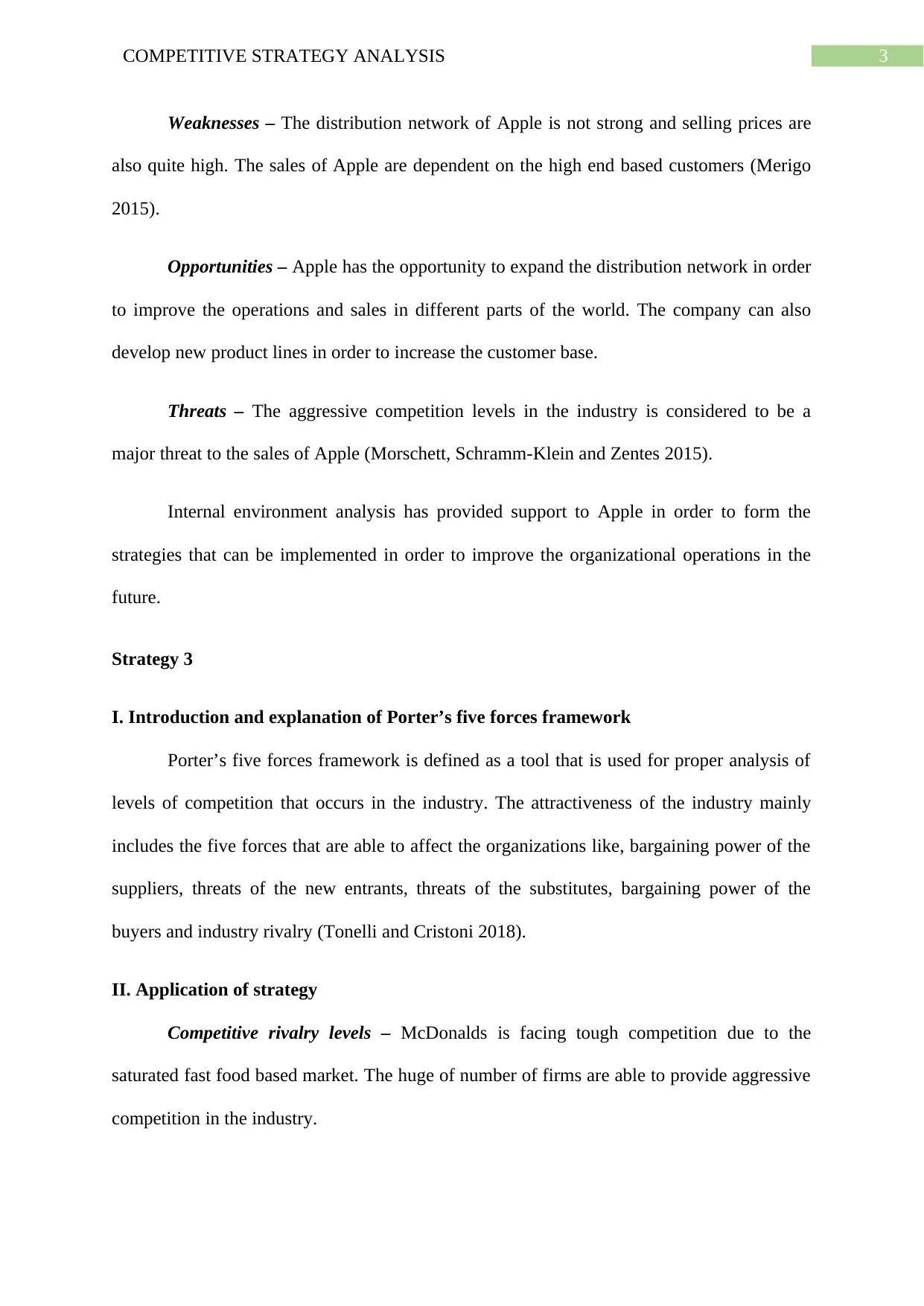
3COMPETITIVE STRATEGY ANALYSIS
Weaknesses – The distribution network of Apple is not strong and selling prices are
also quite high. The sales of Apple are dependent on the high end based customers (Merigo
2015).
Opportunities – Apple has the opportunity to expand the distribution network in order
to improve the operations and sales in different parts of the world. The company can also
develop new product lines in order to increase the customer base.
Threats – The aggressive competition levels in the industry is considered to be a
major threat to the sales of Apple (Morschett, Schramm-Klein and Zentes 2015).
Internal environment analysis has provided support to Apple in order to form the
strategies that can be implemented in order to improve the organizational operations in the
future.
Strategy 3
I. Introduction and explanation of Porter’s five forces framework
Porter’s five forces framework is defined as a tool that is used for proper analysis of
levels of competition that occurs in the industry. The attractiveness of the industry mainly
includes the five forces that are able to affect the organizations like, bargaining power of the
suppliers, threats of the new entrants, threats of the substitutes, bargaining power of the
buyers and industry rivalry (Tonelli and Cristoni 2018).
II. Application of strategy
Competitive rivalry levels – McDonalds is facing tough competition due to the
saturated fast food based market. The huge of number of firms are able to provide aggressive
competition in the industry.
Weaknesses – The distribution network of Apple is not strong and selling prices are
also quite high. The sales of Apple are dependent on the high end based customers (Merigo
2015).
Opportunities – Apple has the opportunity to expand the distribution network in order
to improve the operations and sales in different parts of the world. The company can also
develop new product lines in order to increase the customer base.
Threats – The aggressive competition levels in the industry is considered to be a
major threat to the sales of Apple (Morschett, Schramm-Klein and Zentes 2015).
Internal environment analysis has provided support to Apple in order to form the
strategies that can be implemented in order to improve the organizational operations in the
future.
Strategy 3
I. Introduction and explanation of Porter’s five forces framework
Porter’s five forces framework is defined as a tool that is used for proper analysis of
levels of competition that occurs in the industry. The attractiveness of the industry mainly
includes the five forces that are able to affect the organizations like, bargaining power of the
suppliers, threats of the new entrants, threats of the substitutes, bargaining power of the
buyers and industry rivalry (Tonelli and Cristoni 2018).
II. Application of strategy
Competitive rivalry levels – McDonalds is facing tough competition due to the
saturated fast food based market. The huge of number of firms are able to provide aggressive
competition in the industry.
Secure Best Marks with AI Grader
Need help grading? Try our AI Grader for instant feedback on your assignments.
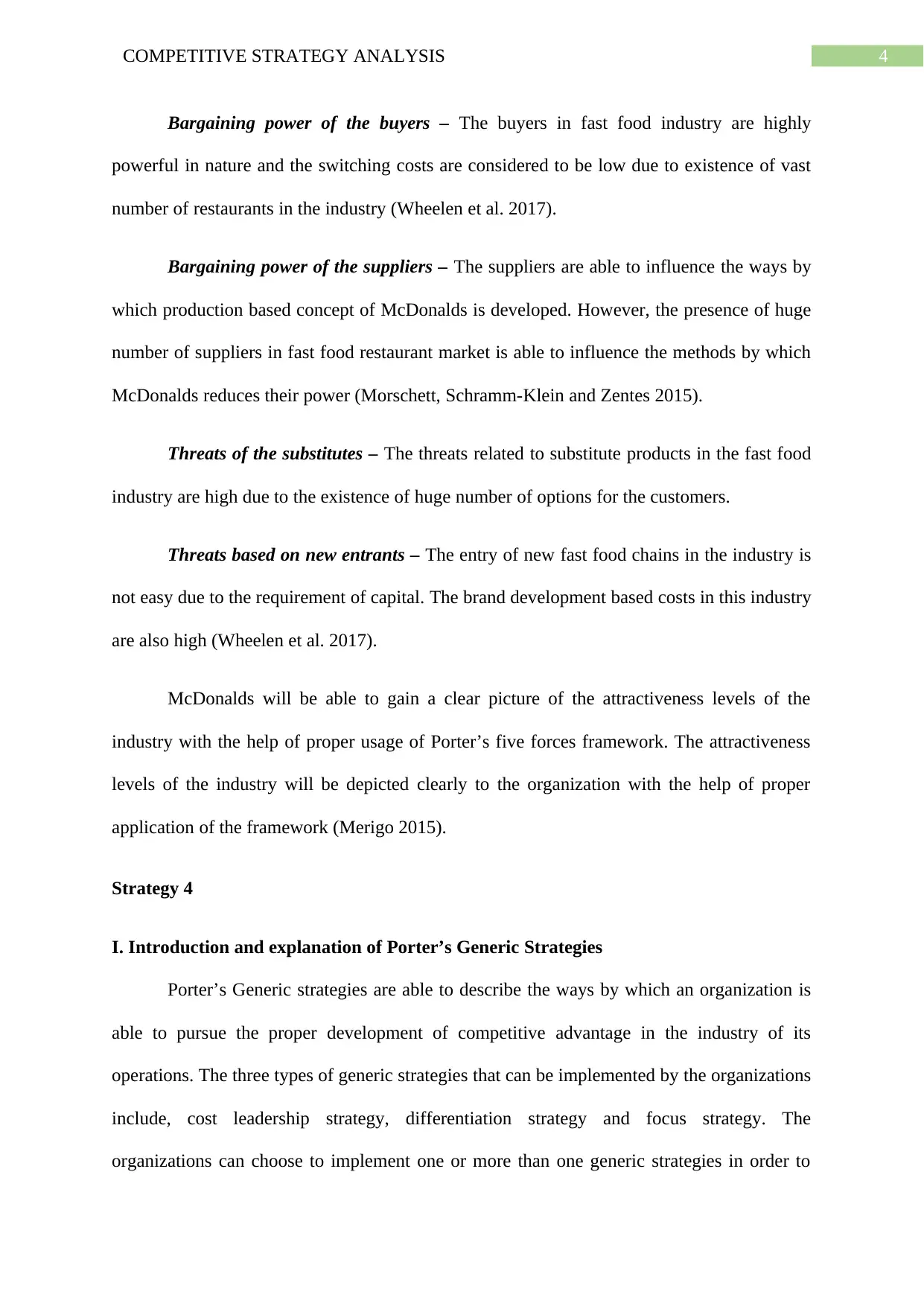
4COMPETITIVE STRATEGY ANALYSIS
Bargaining power of the buyers – The buyers in fast food industry are highly
powerful in nature and the switching costs are considered to be low due to existence of vast
number of restaurants in the industry (Wheelen et al. 2017).
Bargaining power of the suppliers – The suppliers are able to influence the ways by
which production based concept of McDonalds is developed. However, the presence of huge
number of suppliers in fast food restaurant market is able to influence the methods by which
McDonalds reduces their power (Morschett, Schramm-Klein and Zentes 2015).
Threats of the substitutes – The threats related to substitute products in the fast food
industry are high due to the existence of huge number of options for the customers.
Threats based on new entrants – The entry of new fast food chains in the industry is
not easy due to the requirement of capital. The brand development based costs in this industry
are also high (Wheelen et al. 2017).
McDonalds will be able to gain a clear picture of the attractiveness levels of the
industry with the help of proper usage of Porter’s five forces framework. The attractiveness
levels of the industry will be depicted clearly to the organization with the help of proper
application of the framework (Merigo 2015).
Strategy 4
I. Introduction and explanation of Porter’s Generic Strategies
Porter’s Generic strategies are able to describe the ways by which an organization is
able to pursue the proper development of competitive advantage in the industry of its
operations. The three types of generic strategies that can be implemented by the organizations
include, cost leadership strategy, differentiation strategy and focus strategy. The
organizations can choose to implement one or more than one generic strategies in order to
Bargaining power of the buyers – The buyers in fast food industry are highly
powerful in nature and the switching costs are considered to be low due to existence of vast
number of restaurants in the industry (Wheelen et al. 2017).
Bargaining power of the suppliers – The suppliers are able to influence the ways by
which production based concept of McDonalds is developed. However, the presence of huge
number of suppliers in fast food restaurant market is able to influence the methods by which
McDonalds reduces their power (Morschett, Schramm-Klein and Zentes 2015).
Threats of the substitutes – The threats related to substitute products in the fast food
industry are high due to the existence of huge number of options for the customers.
Threats based on new entrants – The entry of new fast food chains in the industry is
not easy due to the requirement of capital. The brand development based costs in this industry
are also high (Wheelen et al. 2017).
McDonalds will be able to gain a clear picture of the attractiveness levels of the
industry with the help of proper usage of Porter’s five forces framework. The attractiveness
levels of the industry will be depicted clearly to the organization with the help of proper
application of the framework (Merigo 2015).
Strategy 4
I. Introduction and explanation of Porter’s Generic Strategies
Porter’s Generic strategies are able to describe the ways by which an organization is
able to pursue the proper development of competitive advantage in the industry of its
operations. The three types of generic strategies that can be implemented by the organizations
include, cost leadership strategy, differentiation strategy and focus strategy. The
organizations can choose to implement one or more than one generic strategies in order to
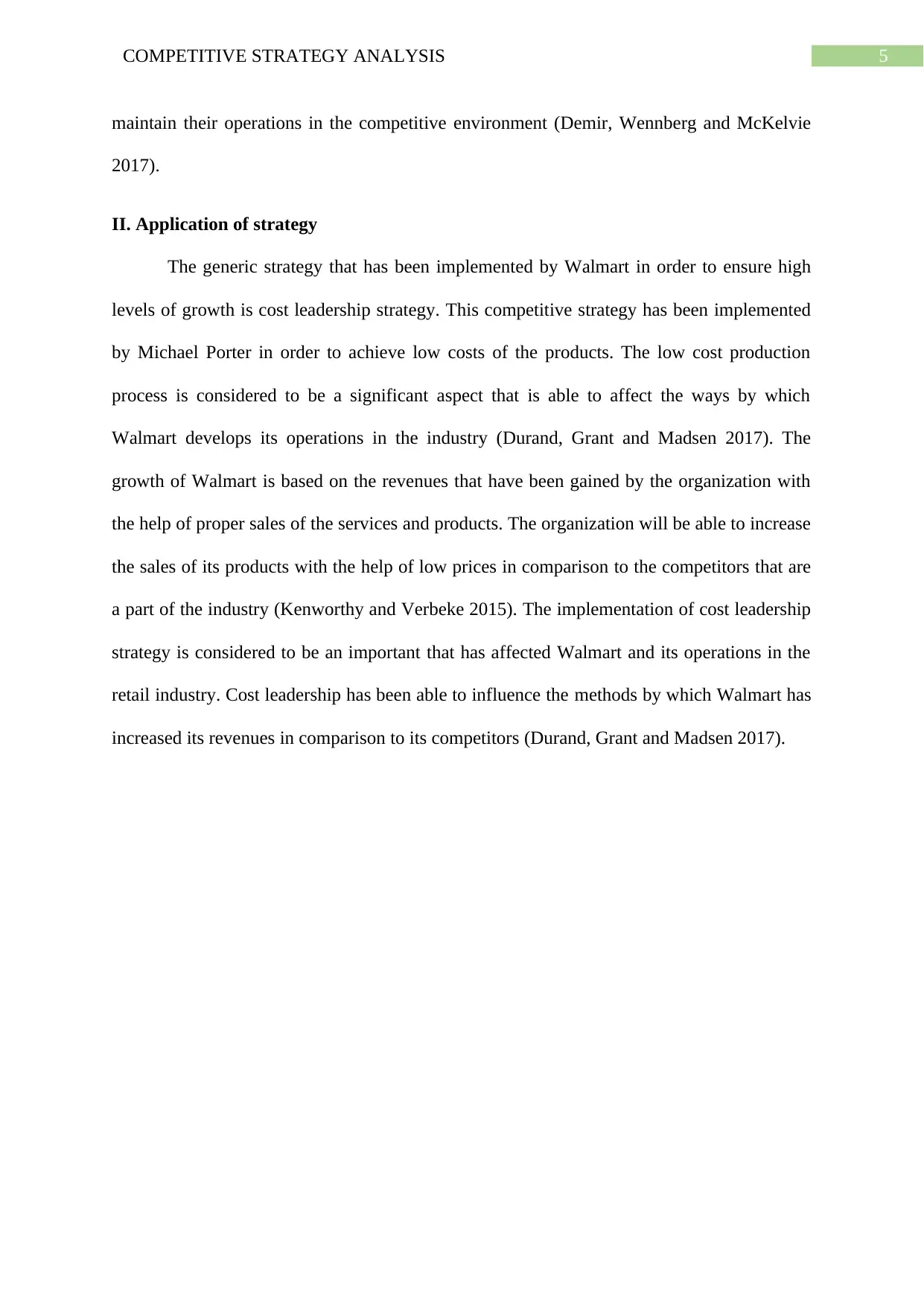
5COMPETITIVE STRATEGY ANALYSIS
maintain their operations in the competitive environment (Demir, Wennberg and McKelvie
2017).
II. Application of strategy
The generic strategy that has been implemented by Walmart in order to ensure high
levels of growth is cost leadership strategy. This competitive strategy has been implemented
by Michael Porter in order to achieve low costs of the products. The low cost production
process is considered to be a significant aspect that is able to affect the ways by which
Walmart develops its operations in the industry (Durand, Grant and Madsen 2017). The
growth of Walmart is based on the revenues that have been gained by the organization with
the help of proper sales of the services and products. The organization will be able to increase
the sales of its products with the help of low prices in comparison to the competitors that are
a part of the industry (Kenworthy and Verbeke 2015). The implementation of cost leadership
strategy is considered to be an important that has affected Walmart and its operations in the
retail industry. Cost leadership has been able to influence the methods by which Walmart has
increased its revenues in comparison to its competitors (Durand, Grant and Madsen 2017).
maintain their operations in the competitive environment (Demir, Wennberg and McKelvie
2017).
II. Application of strategy
The generic strategy that has been implemented by Walmart in order to ensure high
levels of growth is cost leadership strategy. This competitive strategy has been implemented
by Michael Porter in order to achieve low costs of the products. The low cost production
process is considered to be a significant aspect that is able to affect the ways by which
Walmart develops its operations in the industry (Durand, Grant and Madsen 2017). The
growth of Walmart is based on the revenues that have been gained by the organization with
the help of proper sales of the services and products. The organization will be able to increase
the sales of its products with the help of low prices in comparison to the competitors that are
a part of the industry (Kenworthy and Verbeke 2015). The implementation of cost leadership
strategy is considered to be an important that has affected Walmart and its operations in the
retail industry. Cost leadership has been able to influence the methods by which Walmart has
increased its revenues in comparison to its competitors (Durand, Grant and Madsen 2017).
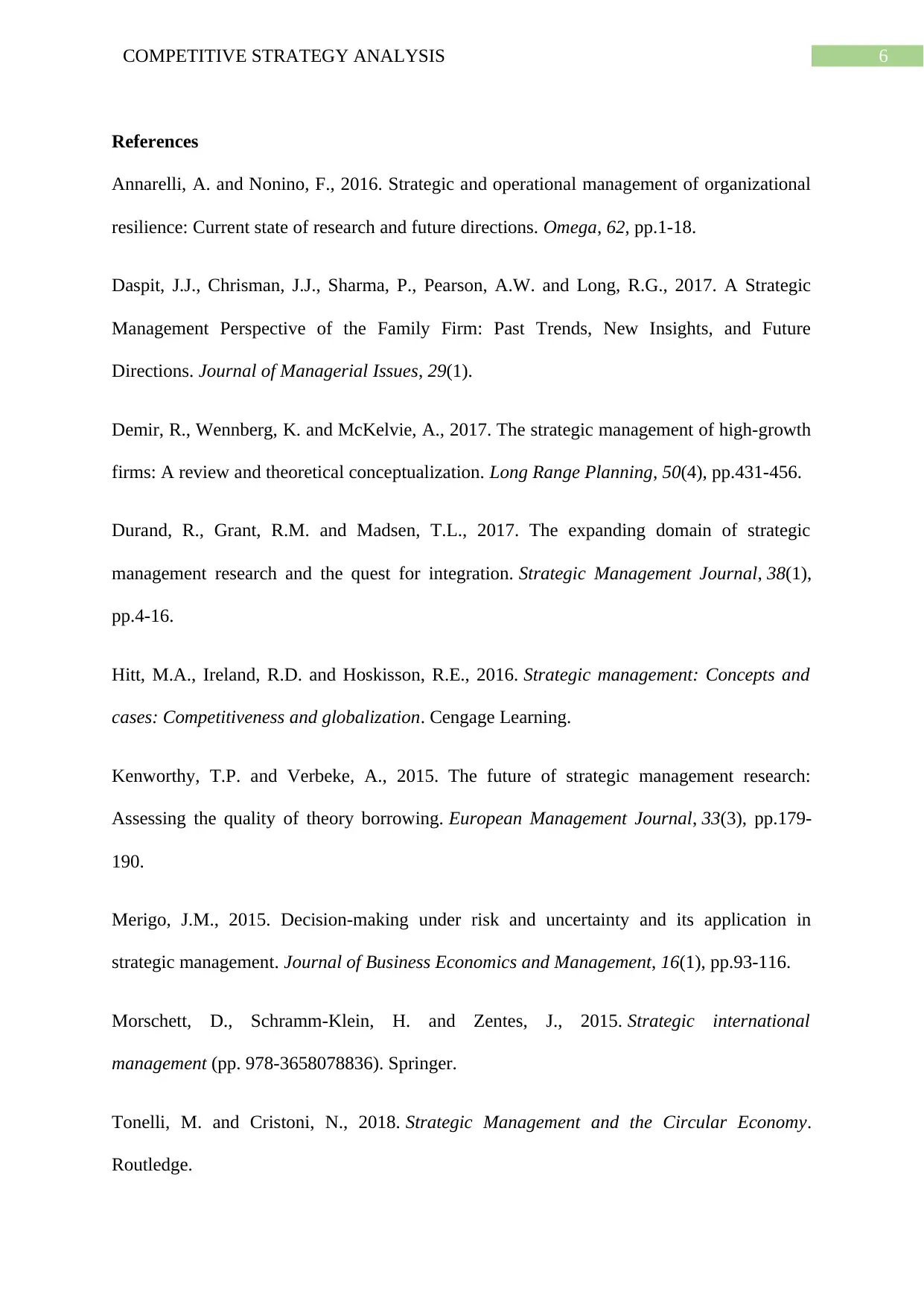
6COMPETITIVE STRATEGY ANALYSIS
References
Annarelli, A. and Nonino, F., 2016. Strategic and operational management of organizational
resilience: Current state of research and future directions. Omega, 62, pp.1-18.
Daspit, J.J., Chrisman, J.J., Sharma, P., Pearson, A.W. and Long, R.G., 2017. A Strategic
Management Perspective of the Family Firm: Past Trends, New Insights, and Future
Directions. Journal of Managerial Issues, 29(1).
Demir, R., Wennberg, K. and McKelvie, A., 2017. The strategic management of high-growth
firms: A review and theoretical conceptualization. Long Range Planning, 50(4), pp.431-456.
Durand, R., Grant, R.M. and Madsen, T.L., 2017. The expanding domain of strategic
management research and the quest for integration. Strategic Management Journal, 38(1),
pp.4-16.
Hitt, M.A., Ireland, R.D. and Hoskisson, R.E., 2016. Strategic management: Concepts and
cases: Competitiveness and globalization. Cengage Learning.
Kenworthy, T.P. and Verbeke, A., 2015. The future of strategic management research:
Assessing the quality of theory borrowing. European Management Journal, 33(3), pp.179-
190.
Merigo, J.M., 2015. Decision-making under risk and uncertainty and its application in
strategic management. Journal of Business Economics and Management, 16(1), pp.93-116.
Morschett, D., Schramm-Klein, H. and Zentes, J., 2015. Strategic international
management (pp. 978-3658078836). Springer.
Tonelli, M. and Cristoni, N., 2018. Strategic Management and the Circular Economy.
Routledge.
References
Annarelli, A. and Nonino, F., 2016. Strategic and operational management of organizational
resilience: Current state of research and future directions. Omega, 62, pp.1-18.
Daspit, J.J., Chrisman, J.J., Sharma, P., Pearson, A.W. and Long, R.G., 2017. A Strategic
Management Perspective of the Family Firm: Past Trends, New Insights, and Future
Directions. Journal of Managerial Issues, 29(1).
Demir, R., Wennberg, K. and McKelvie, A., 2017. The strategic management of high-growth
firms: A review and theoretical conceptualization. Long Range Planning, 50(4), pp.431-456.
Durand, R., Grant, R.M. and Madsen, T.L., 2017. The expanding domain of strategic
management research and the quest for integration. Strategic Management Journal, 38(1),
pp.4-16.
Hitt, M.A., Ireland, R.D. and Hoskisson, R.E., 2016. Strategic management: Concepts and
cases: Competitiveness and globalization. Cengage Learning.
Kenworthy, T.P. and Verbeke, A., 2015. The future of strategic management research:
Assessing the quality of theory borrowing. European Management Journal, 33(3), pp.179-
190.
Merigo, J.M., 2015. Decision-making under risk and uncertainty and its application in
strategic management. Journal of Business Economics and Management, 16(1), pp.93-116.
Morschett, D., Schramm-Klein, H. and Zentes, J., 2015. Strategic international
management (pp. 978-3658078836). Springer.
Tonelli, M. and Cristoni, N., 2018. Strategic Management and the Circular Economy.
Routledge.
Paraphrase This Document
Need a fresh take? Get an instant paraphrase of this document with our AI Paraphraser
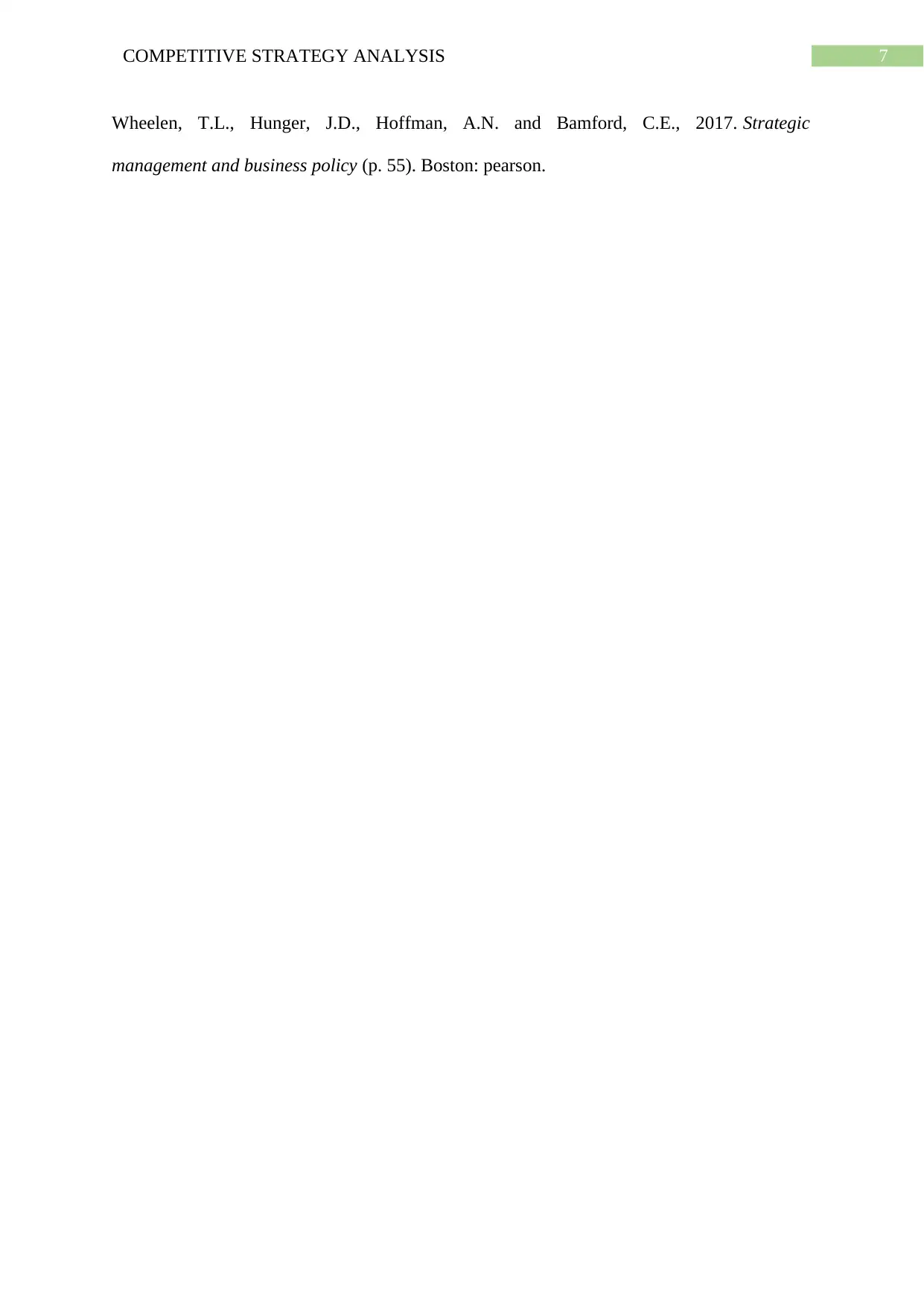
7COMPETITIVE STRATEGY ANALYSIS
Wheelen, T.L., Hunger, J.D., Hoffman, A.N. and Bamford, C.E., 2017. Strategic
management and business policy (p. 55). Boston: pearson.
Wheelen, T.L., Hunger, J.D., Hoffman, A.N. and Bamford, C.E., 2017. Strategic
management and business policy (p. 55). Boston: pearson.
1 out of 8
Related Documents
Your All-in-One AI-Powered Toolkit for Academic Success.
+13062052269
info@desklib.com
Available 24*7 on WhatsApp / Email
![[object Object]](/_next/static/media/star-bottom.7253800d.svg)
Unlock your academic potential
© 2024 | Zucol Services PVT LTD | All rights reserved.





